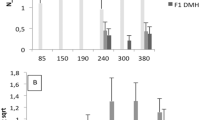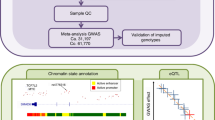Abstract
Only a small proportion of cancers result from familial cancer syndromes with Mendelian inheritance. Nonfamilial, 'sporadic' cancers, which represent most cancer cases, also have a significant hereditary component1,2, but the genes involved have low penetrance and are extremely difficult to detect2,3. Therefore, mapping and cloning of quantitative trait loci (QTLs) for cancer susceptibility in animals could help identify homologous genes in humans. Several cancer-susceptibility QTLs have been mapped in mice and rats4,5, but none have been cloned so far. Here we report the positional cloning of the mouse gene Scc1 (Susceptibility to colon cancer 1)6 and the identification of Ptprj, encoding a receptor-type protein tyrosine phosphatase, as the underlying gene. In human colon, lung and breast cancers, we show frequent deletion of PTPRJ, allelic imbalance in loss of heterozygosity (LOH) and missense mutations. Our data suggest that PTPRJ is relevant to the development of several different human cancers.
This is a preview of subscription content, access via your institution
Access options
Subscribe to this journal
Receive 12 print issues and online access
$209.00 per year
only $17.42 per issue
Buy this article
- Purchase on Springer Link
- Instant access to full article PDF
Prices may be subject to local taxes which are calculated during checkout



Similar content being viewed by others
References
Lichtenstein, P. et al. Environmental and heritable factors in the causation of cancer—analyses of cohorts of twins from Sweden, Denmark, and Finland. N. Engl. J. Med. 343, 78–85 (2000).
Ponder, B.A. Cancer genetics. Nature 411, 336–341 (2001).
Weiss, K.M. & Terwilliger, J.D. How many diseases does it take to map a gene with SNPs? Nature Genet. 26, 151–157 (2000).
Balmain, A. & Nagase, H. Cancer resistance genes in mice: models for the study of tumour modifiers. Trends Genet. 14, 139–144 (1998).
van Wezel, T., Lipoldova, M. & Demant, P. in Genotype to Phenotype (eds Malcolm, S. & Goodship, S.) 107–129 (BIOS Scientific Publishers, Oxford, 2001).
Moen, C.J., Groot, P.C., Hart, A.A., Snoek, M. & Demant, P. Fine mapping of colon tumor susceptibility (Scc) genes in the mouse, different from the genes known to be somatically mutated in colon cancer. Proc. Natl Acad. Sci. USA 93, 1082–1086 (1996).
Venter, J.C. et al. The sequence of the human genome. Science 291, 1304–1351 (2001).
Lander, E.S. et al. Initial sequencing and analysis of the human genome. Nature 409, 860–921 (2001).
Keane, M.M., Lowrey, G.A., Ettenberg, S.A., Dayton, M.A. & Lipkowitz, S. The protein tyrosine phosphatase DEP-1 is induced during differentiation and inhibits growth of breast cancer cells. Cancer Res. 56, 4236–4243 (1996).
Trapasso, F. et al. Rat protein tyrosine phosphatase η suppresses the neoplastic phenotype of retrovirally transformed thyroid cells through the stabilization of p27(Kip1). Mol. Cell. Biol. 20, 9236–9246 (2000).
Kuramochi, S. et al. Molecular cloning and characterization of Byp, a murine receptor-type tyrosine phosphatase similar to human DEP-1. FEBS Lett. 378, 7–14 (1996).
Autschbach, F. et al. Expression of the membrane protein tyrosine phosphatase CD148 in human tissues. Tissue Antigens 54, 485–498 (1999).
Anastasiadis, P.Z. & Reynolds, A.B. The p120 catenin family: complex roles in adhesion, signaling and cancer. J. Cell Sci. 113, 1319–1334 (2000).
Wielenga, V.J., van der Neut, R., Offerhaus, G.J. & Pals, S.T. CD44 glycoproteins in colorectal cancer: expression, function, and prognostic value. Adv. Cancer Res. 77, 169–187 (2000).
Honda, H., Inazawa, J., Nishida, J., Yazaki, Y. & Hirai, H. Molecular cloning, characterization, and chromosomal localization of a novel protein-tyrosine phosphatase, HPTP η. Blood 84, 4186–4194 (1994).
Ostman, A., Yang, Q. & Tonks, N.K. Expression of DEP-1, a receptor-like protein-tyrosine-phosphatase, is enhanced with increasing cell density. Proc. Natl Acad. Sci. USA 91, 9680–9684 (1994).
Pietenpol, J.A. et al. Assignment of the human p27Kip1 gene to 12p13 and its analysis in leukemias. Cancer Res. 55, 1206–1210 (1995).
Fero, M.L., Randel, E., Gurley, K.E., Roberts, J.M. & Kemp, C.J. The murine gene p27Kip1 is haplo-insufficient for tumour suppression. Nature 396, 177–180 (1998).
Krimpenfort, P., Quon, K.C., Mooi, W.J., Loonstra, A. & Berns, A. Loss of p16Ink4a confers susceptibility to metastatic melanoma in mice. Nature 413, 83–86 (2001).
Kwabi-Addo, B. et al. Haploinsufficiency of the Pten tumor suppressor gene promotes prostate cancer progression. Proc. Natl Acad. Sci. USA 98, 11563–11568 (2001).
Inoue, K. et al. Disruption of the ARF transcriptional activator DMP1 facilitates cell immortalization, Ras transformation, and tumorigenesis. Genes Dev. 14, 1797–1809 (2000).
Rhodes, M. et al. A high-resolution microsatellite map of the mouse genome. Genome Res. 8, 531–542 (1998).
Riley, J. et al. A novel, rapid method for the isolation of terminal sequences from yeast artificial chromosome (YAC) clones. Nucleic Acids Res. 18, 2887–2890 (1990).
Florijn, R.J. et al. High-resolution DNA Fiber-FISH for genomic DNA mapping and colour bar-coding of large genes. Hum. Mol. Genet. 4, 831–836 (1995).
Rozen, S. & Skaletsky, H. Primer3 on the WWW for general users and for biologist programmers. Methods Mol. Biol. 132, 365–386 (2000).
Emmert-Buck, M.R. et al. Laser capture microdissection. Science 274, 998–1001 (1996).
Dib, C. et al. A comprehensive genetic map of the human genome based on 5,264 microsatellites. Nature 380, 152–154 (1996).
Thompson, J.D., Higgins, D.G. & Gibson, T.J. CLUSTALW: improving the sensitivity of progressive multiple sequence alignment through sequence weighting, position-specific gap penalties and weight matrix choice. Nucleic Acids Res. 22, 4673–4680 (1994).
Altschul, S.F., Gish, W., Miller, W., Myers, E.W. & Lipman, D.J. Basic local alignment search tool. J. Mol. Biol. 215, 403–410 (1990).
Altschul, S.F. et al. Gapped BLAST and PSI-BLAST: a new generation of protein database search programs. Nucleic Acids Res. 25, 3389–3402 (1997).
Acknowledgements
The authors thank V. Theodorou, E. Dijsselbloem, E. Anthony and M. Treur for technical assistance; J. de Moes, E. Delzenne-Goette and M. Timpico for help with breeding, tumor induction and autopsies; A. Berns, M. Snoek, J. Jonkers, H. Mikkers and A. Cleton-Jansen for helpful comments on the manuscript; E. Robanus for the human BAC filters; R. Pruntel for all the ABI runs; and S. Banus and H. van Kranen for their help with pyrosequencing. This work was supported by grants from the Dutch Cancer Society and the Dutch Basic Research Organization.
Author information
Authors and Affiliations
Corresponding author
Ethics declarations
Competing interests
The authors declare no competing financial interests.
Supplementary information
Rights and permissions
About this article
Cite this article
Ruivenkamp, C., van Wezel, T., Zanon, C. et al. Ptprj is a candidate for the mouse colon-cancer susceptibility locus Scc1 and is frequently deleted in human cancers. Nat Genet 31, 295–300 (2002). https://doi.org/10.1038/ng903
Received:
Accepted:
Published:
Issue Date:
DOI: https://doi.org/10.1038/ng903
This article is cited by
-
PTPRJ is downregulated in cervical squamous cell carcinoma
Journal of Genetics (2022)
-
Protein tyrosine phosphatases: promising targets in pancreatic ductal adenocarcinoma
Cellular and Molecular Life Sciences (2019)
-
Genetic alterations of protein tyrosine phosphatases in human cancers
Oncogene (2015)
-
In silico analyses reveal common cellular pathways affected by loss of heterozygosity (LOH) events in the lymphomagenesis of Non-Hodgkin’s lymphoma (NHL)
BMC Genomics (2014)
-
The regulatory roles of phosphatases in cancer
Oncogene (2014)



